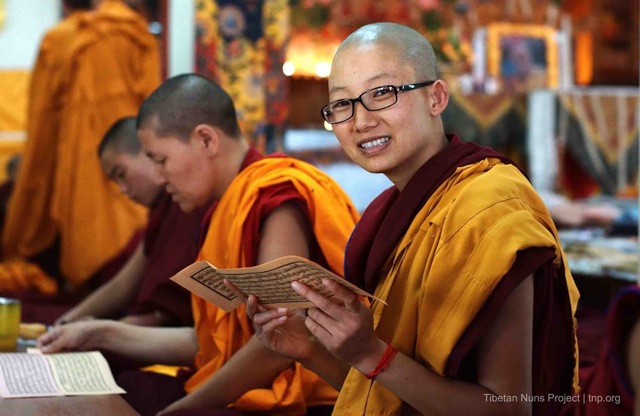Scientists have confirmed that expressing gratitude and giving thanks makes us happier and healthier.
Here at the Tibetan Nuns Project, we are very grateful for our global family of supporters who care deeply about the nuns and who have joined with us to help these brave and dedicated women.
Many of our supporters have told us via our survey that, by giving to the Tibetan Nuns Project, they also feel happier and are grateful for this opportunity to help.
Today, with their permission, we’d like to share some of their stories and words.

Peggy in Washington says, “It is heartfelt when I exchange letters with my nun! It is precious to hear about the journey of her education and spiritual development. She says she prays for me daily!!”
Jane in Los Angeles wrote and told us: “I care about supporting the peacemakers in the world—those who embody and teach compassion and peace. It is important to further both inner wisdom and compassionate action. A person who lives this not only lights the path for others, but lights their candle also.”

Elizabeth in California told us her story. She said, “I taught the nuns from 1994-1996 when their nunnery at Dolma Ling was new. In fact, it was not even finished when the nuns moved into the buildings. My admiration for the nuns grew by leaps and bounds when I was teaching them and I was honored in sharing their lives. In the years since, I am always amazed by their dedication, perseverance and reverence towards their studies and values. The life of a nun is not easy. It is marked by tremendous sacrifices. In spite of it all, the nuns keep on. ‘Never give up,’ said the Dalai Lama. They never have. They deserve my support, and yours.”
Felix in Ohio told us, “I support the Tibetan Nuns Project because they, as individuals, are very important. The nuns do incredible work like teaching and praying for others in need. They need our help and anyone else who can come forward to help. There are many nuns and just not enough money to support them. That’s why we are helping. Each month we will be able to sleep better knowing that our contribution of $30 a month for the Tibetan Nuns Project is going to good use. Thank you so much for this great opportunity.”

A donor said, “As a practitioner of Tibetan Buddhism I feel I’ve been given a gift I will be unwrapping for the rest of this life (and future lives!). It’s such a good feeling to be able to give back, even if it’s just a little, for the support and programs for the nuns. These women and girls have so much potential and it’s wonderful to be able to help them realize that potential.” Photo by Brian Harris
Sondra in Texas said, “I am acutely aware of the displacement of Tibetans and the pain it has caused. Especially for the monks and nuns. I live in a society that has an overabundance of material goods. I am a retired nurse and would like to share some of my good fortune with these women.”

Laura in Canada wrote, “I have a great deal of compassion for the Tibetan people and the struggles that they endure. Sponsoring a nun through the Tibetan Nun’s Project, purchasing products made by them, and making a donation for pujas is my simple way of saying that I care. I am committed to the education and support of these women. Thank you to the Tibetan Nun’s Project for being the liaison.” Photo by Brian Harris








